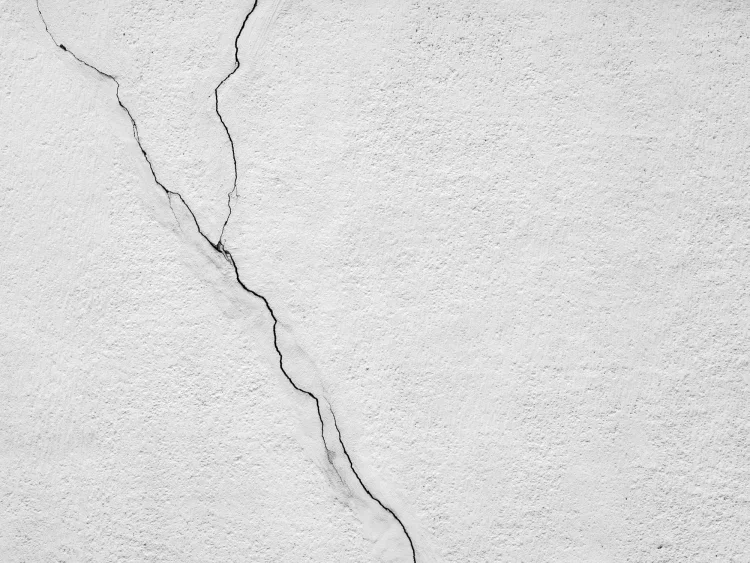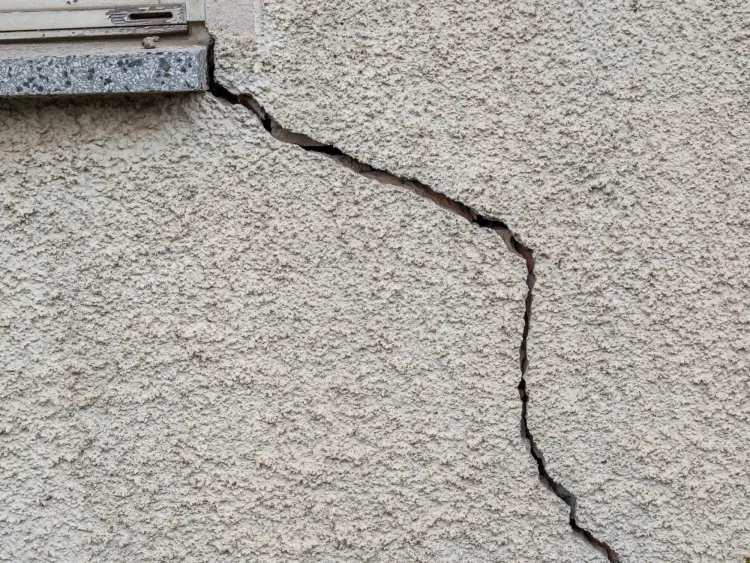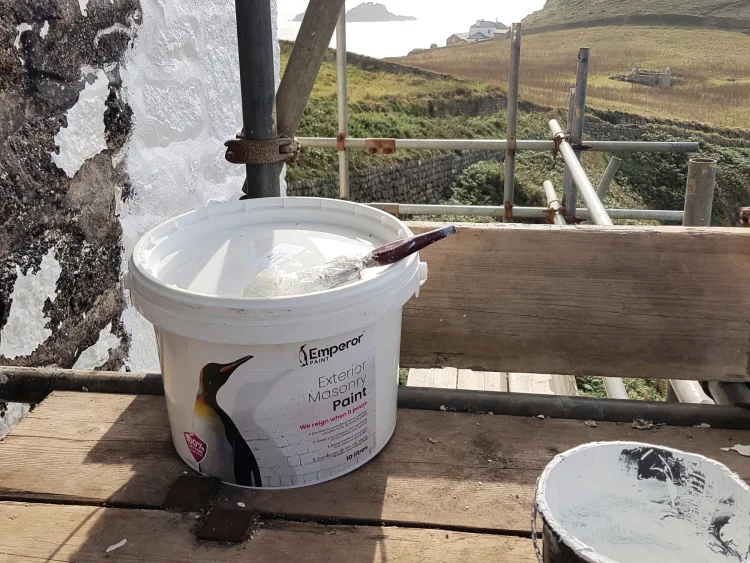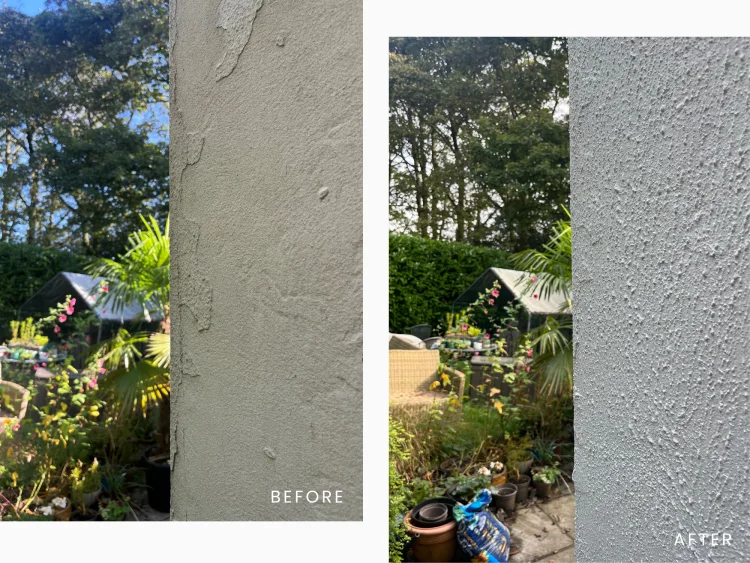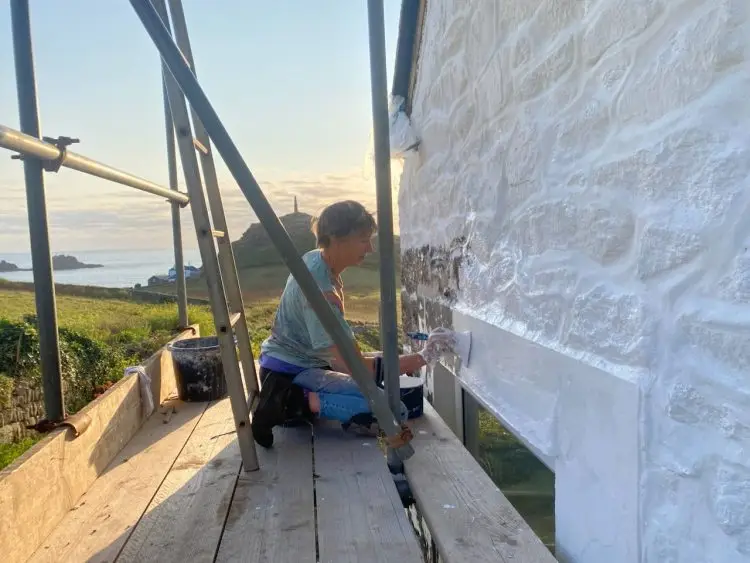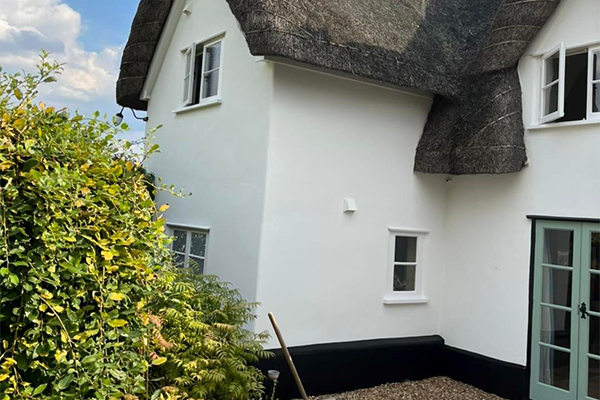The Ultimate Guide To Repairing Cracked Render
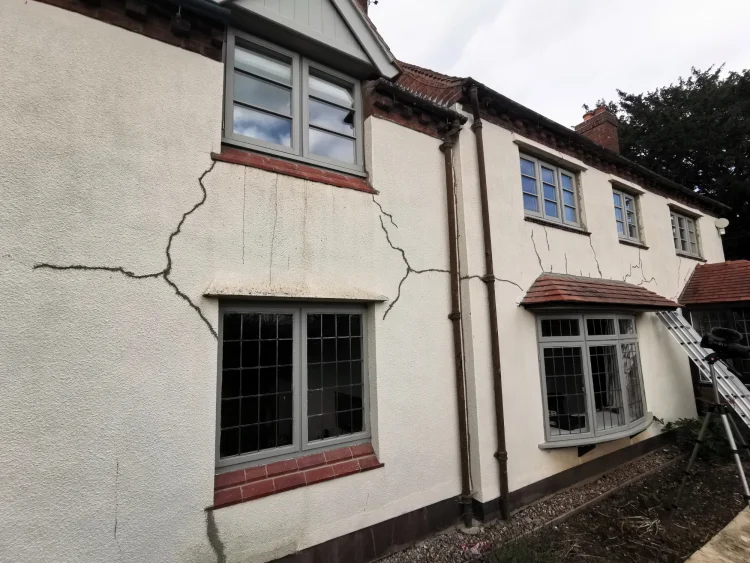
Cracked render is one of the most common exterior problems homeowners face. Left untreated, it not only causes an eye-sore but can also lead to damp and further damage.
In this guide we’ll explain everything you need to know about repairing cracked render and restoring your walls, including:
- Why render cracks
- How to repair cracked render
- How to repaint so you can’t see the cracks
Why Does Render Crack?
Render is a common form of exterior finish in the UK. It comes in various forms, from traditional sand and cement render to more modern renders such as K-Rend.
Render can crack for several reasons, so understanding why it may have happened is crucial to address the root cause.
Here are the main causes of cracked render:
1. POOR APPLICATION
Cracking can occur as early as the application process.
If the render dries too quickly or isn’t properly cured, it can result in a weaker finish.
Furthermore, the use of low-quality materials, incorrect mix ratios or poor surface preparation can all weaken the render.
These issues can often cause a brittle surface that can begin to crack within months of application.
2. MOVEMENT
Render is a rigid building material and our homes naturally move over time due to expansion, contraction or settlement.
When this happens, the render can’t flex enough and the result is cracking across the surface. These often form around weak points such as windows, corners or joints.
Due to the problems caused by movement, modern render systems often have added flexibility or are applied with reinforcing mesh to reduce the risk of cracking.
3. MOISTURE
The most common causes of cracked render, along with any other damage to exterior walls, is exposure to weathering.
Wind and rain can cause moisture to enter hairline cracks or be absorbed into the render itself. Once trapped behind the surface, the water expands and can open-up cracks within the surface.
This then allows more moisture to enter through the render, causing even larger cracks and further water ingress.
Over time, this not only worsens the damage but can cause penetrating damp on the inside wall, particularly in solid wall properties where there is no cavity wall to stop the transfer of moisture from external wall to the internal wall.
Once any cracks begin to appear on render, you must act quickly in order to limit the damage caused both internally and externally.
How To Repair Cracked Render
If you are looking to repair cracked render yourself at home, it is important that you follow a step-by-step process carefully to ensure you achieve results that will last long-term.
YOU WILL NEED:
- A mini-disk cutter or oscillating tool
- Exterior filler (small areas)
- Render mix (large areas)
- A wire brush
- Sandpaper
- Filling knife
- Masonry cleaner
1. IDENTIFY THE DAMAGE
The extent of the repairs you will need to make depends on the current state of the render.
If there are just a number of small hairline cracks, an exterior filler will usually be suitable for making repairs.
If you have large open sections of render missing, these will have to repaired using a suitable render mix.
There might be sections of render that appear to be sound, but may have delaminated from the wall. To establish whether any render needs to be removed, tap on the surface. If you can hear that it is hollow, you must remove this as eventually it will completely fail if repairs are not made.
2. CLEAN THE SURFACE
Before any repairs are made to the render, you must ensure the surface is clean.
A clean surface ensures dirt and fungus can’t stop the repairs from bonding properly and makes sure they stand the test of time.
Apply a suitable cleaning solution like Emperor Exterior Cleaner that contains a fungicide to the render in order to remove any algae or other green growth.
3. OPEN UP CRACKS
While it may seem counter-productive, sometimes you need to make cracks larger in order to properly repair them properly.
This is because small hairline cracks are often too narrow for filler to bond effectively. If left as they are, the filler will sit on the surface rather than filling the full gap, leading to it cracking when the wall moves again.
Using a tool like a mini-disk cutter, multi-tool or scraper, run a cut through each crack.
After widening, you can then remove any dust from the crack. Any rubble and dust will impact the ability for the filler to perform, so making sure the crack is a clean open channel is important.
4. FILL THE CRACKS
Once the cracks are clean and open, you can begin repairing them.
For smaller cracks, any ready-mixed exterior filler will be suitable. For deeper cracks, a filler that comes in a cartridge and is applied with an applicator gun is going to be best.
If using a filling knife, work the filler back and forth to fill the hole as much as possible. Slightly overfilling the hole can help counter any shrinkage as the filler dries.
It’s important that you allow the filler to dry fully according to the instructions. Not allowing the filler to dry fully can risk the repair cracking again once painted.
5. SANDING
Once the filler has completely dried, use a filling knife to remove any large chunks of filler.
Once you have done this, you can then use sandpaper to sand the filler back to a smooth finish
How To Prevent Render From Cracking
Once you have taken the time to repair your cracked render, the last thing you want is for them to reappear.
In most cases, the cause is water entering the render and getting behind the surface. To stop this, your render needs:
- Water protection to keep rain out
- High breathability to let water vapour escape
There are several types of products designed to protect render:
- Masonry paint – These coloured paints coat the surface in a protective layer.
- Masonry cream – These are clear, water repellent coatings that soak into the surface rather than sitting on top of it. They maintain the natural appearance of render while helping to prevent water absorption.
- Sealer – These products form a film over the top of masonry that seals it. While they prevent water from entering, they also trap moisture in the render.
Masonry paint is the most popular option because it not only protects but also refreshes the appearance of the render, covering the repairs.
However, contrary to popular belief, standard masonry paints in some cases can increase the risk of damage to render.
To protect render long-term a masonry paint must repel rainwater while maintaining the render’s natural ability to release water vapour.
With heavier rainfall and ageing housing stock across the UK, many masonry paints today aren’t up to the task.
That’s why we developed Emperor Masonry Paint which uses cutting-edge nano-technology to line the pores of render without sealing them. This allows it to create a super hydrophobic (ultra water repellent) surface that causes rain to simply roll away, while remaining highly breathable.
An independent 25 year weathering test conducted by a UKAS accredited laboratory found that Emperor Masonry Paint showed no signs of deterioration in performance or appearance, which is why it comes with a lifetime guarantee, ensuring it protect render in all weather conditions.
Learn more: How nano-technology works
How To Disguise Repairs
Once cracks and holes have been repaired, one of the biggest challenges is blending them to match the rest of the render.
Renders are very rarely smooth, so when you patch an area, the texture often looks different. Once painted, even a small difference in texture can stand out.
To help disguise repairs you could use a product like Emperor Textured Basecoat which can create a wide range of textured finishes quickly and easily using a brush or textured roller.
To disguise repairs simply roll over the surface with either a light, medium or rough textured roller using Emperor Textured Basecoat. The specially designed rollers will create the texture themselves, allowing you to match the repair and blend it with the existing render.
Crucially, the basecoat is highly breathable, so you aren’t compromising the performance of your render.
You can also achieve a textured finish using the filler you are using, but this generally only works on small areas and if the render is smooth.
Frequently Asked Questions
Will paint cover hairline cracks?
No, in most cases masonry paint will not cover hairline cracks. Paint may fill them temporarily, but as the wall moves or takes on moisture, the cracks will reappear.
For lasting results, it’s best to fill the cracks before painting to ensure they do not allow moisture to enter the wall in the future.
How long should I wait to paint over cracks I have repaired?
Making sure you allow your repairs to fully dry is crucial before painting.
The drying time depends on the product you used, thickness of the repair and weather conditions.
As a rule of thumb, smaller repairs using filler can take 24 hours, while deeper re-rendered areas may take 4-6 weeks to fully dry.
Why does render need to breathe?
Breathability is a term that many people are confused with when it comes to exterior paints and renders.
Breathability is crucial for ensuring that the interior of the property can release moisture that naturally builds up from condensation.
This means that while preventing moisture entering the building is crucial, allowing moisture to release from the building is even more important, as if it is blocked it will cause significant damage to the building materials and leads to huge damp problems.
This is why any paint or render must be breathable to allow this moisture to escape.
Breathability is measured with an SD value, with anything under 0.5 being considered breathable, but generally speaking anything below 0.1 being highly breathable.
For example, Emperor Masonry Paint has a breathability rating of 0.03, making it highly breathable.
Learn more: The science of breathability
If you have more questions about how to repair your cracked render our in-house team of experts are always here should you need us. You can reach them by emailing [email protected] or calling 01254 936121.
Ready to start? Take our handy quiz to get personalised recommendations and find the right products to paint lime render in a few clicks.
This article was written by the Emperor Technical Team, a group of experts with an average of over 25 years experience in the building industry. They work daily with homeowners, tradespeople and specification professionals to deliver practical, expert guidance that promotes long-term results, supports wall health and helps create homes that are prepared for the future.


